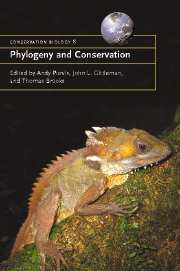Book contents
18 - Predicting future speciation
Published online by Cambridge University Press: 04 December 2009
Summary
INTRODUCTION
Humans are changing the environment in major ways. Vast areas of wild habitats have been converted to human land use or semi-natural habitat (Nepstad et al. 1999; Achard et al. 2002). Species are being transplanted beyond their natural ranges (Mooney & Hobbs 2000), maintained in artificially high abundance for human use, or driven to rarity or extinction by direct exploitation (Reynolds et al. 2001). Global climates are experiencing changes in temperature, precipitation, CO2 concentrations and many other aspects (Intergovernmental Panel on Climate Change: www.ipcc.ch). Together these changes are having major effects on biodiversity (Sala et al. 2000; McCarty 2001; Parmesan & Yohe 2003). Concern normally focuses on rarity or loss of species. However, as well as affecting extinction rates, human activities are likely to have major effects on the future evolution of life on Earth: the future arena for evolution will differ in several key ways from that preceding human impact on the environment. Recently, Myers & Knoll (2001) argued that biodiversity research and management should place greater emphasis on the future of evolution, particularly on the possibility that human activities might inhibit speciation and thereby worsen the effects of current extinctions. But can we predict the future of speciation, and if so, should we manage it?
The task of predicting future speciation requires that we understand the processes that governed speciation leading to the present-day or past biota. However, general causes and trends of speciation are notoriously difficult to study owing to the long timescales of processes involved.
- Type
- Chapter
- Information
- Phylogeny and Conservation , pp. 400 - 418Publisher: Cambridge University PressPrint publication year: 2005
References
- 5
- Cited by

